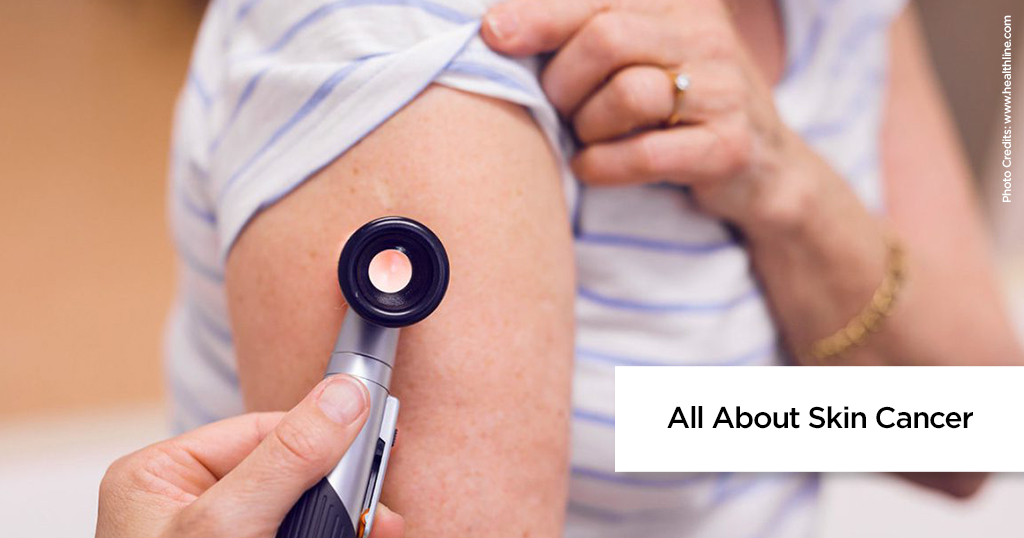Skin cancer is not just a cancer of the West. Know the facts so you may prevent it.
As the name suggests, skin cancer attacks the skin tissue and refers to a condition wherein abnormal skin cells start growing uncontrollably. Skin cancer is amongst the fastest growing cancer types of recent times and we need to be aware of this potentially life threatening condition.
Skin Cancer
The largest organ in the human body, our skin, has many functions – it regulates body temperature, protects the body from various infections, diseases and pathogens and also stores water and synthesizes Vitamin D and fat. Whenever skin cells get exposed to the sun’s harmful UV rays, they become damaged and undergo a structural and functional change.
Types of skin cancer
Skin cancers mostly develop in the epidermis which is the top layer of the skin.
Broadly, there are two different kinds of skin cancer:
- Non-melanoma – It includes basal cell carcinoma and squamous cell carcinoma of the skin. Squamous cells are flat cells in the outer (upper) part of the epidermis that constantly shed as new ones are formed. When these cells grow out of control, they can develop into squamous cell cancer or carcinoma. Basal cells are cells found in the lower part of the epidermis, which is called the basal cell layer. These cells divide constantly to form new cells to replace squamous cells which wear off the surface of the skin. As basal cells move up in the epidermis, they get flatter, finally becoming squamous cells. Skin cancers that begin in the basal cell layer are known as basal cell carcinomas or basal cell skin cancers.
- Melanoma – This rare form of cancer is the most serious of all as it aggressively spreads to other body parts and can be fatal. It leads to uncontrolled growth of melanocytes that affect the production of pigment.
Causes of skin cancer
Environmental, as well as genetic factors, can trigger skin cancer:
- Ultraviolet radiation or UV rays – sunlight can cause damage to DNA cells over a period of time, thereby permanently altering their structure. Artificial sources with harmful radiation like tanning beds, solariums and sunlamps too can cause skin cancer, sunburn and skin irritation.
- Fair complexion – People with lighter skin tone, hair and eyes are more prone to skin cancer as fair skin has a lower amount of melanin pigment, which forms natural protection for the skin.
- Family history – An individual with a positive history of melanoma has a higher risk of developing skin malignancy.
- Age – The older you get, the higher are your chances of contracting this tumour. People above the age of 40 are at a higher risk of contracting skin cancer.
- Too much sun exposure – Spending a large amount of time outdoors increases the chances of contracting skin cancer.
Here’s why you should be using sunscreen
- Moles – The bigger the size, the greater the risk. People with a large number of dysplastic nevi (unusual moles) are at increased risk of developing cancerous moles. If there is a recent increase in the size of the mole, a change in the colour or the appearance of irregular border, it’s wise to report it to a dermatologist.
- Immune system – If a person has a weak immune system due to reasons such as organ transplant, leukaemia or HIV, then his chances of developing cancer increase.
Symptoms of skin cancer
The skin can appear to be shiny, small, waxy, rough, crusty and red. Some symptoms of this disease are:
- Change in the size of a mole – When a mole’s diameter increases beyond 6mm or there’s the formation of new skin with bumps and nodes.
- Change in the colour of a mole – When the infected skin completely loses its colour or becomes darker than the surrounding normal skin.
- Change in the sensation of a mole – When the area becomes itchy, painful or tender.
- When the borders of moles becoming irregular, notched and ragged
- When an ulcer refuses to heal
- When one half of the mole area becomes asymmetrically improportionate to the other half
Tests and diagnosis for skin cancer
At first, a dermatologist examines the patient’s skin to look for any unwanted changes and depending on the findings, he or she may recommend a biopsy. If skin cancer is detected, it is then tested for how advanced it is. Skin cancer has two stages:
- Local – an initial stage where the cancer has spread only to the surface of skin.
- Metastatic – an advanced stage where cancer has spread beyond the surface of the skin.
Treatment of skin cancer
Surgery remains the most common treatment for most cancers, including skin cancer.
- Mohs micrographic surgery – this surgery is used for removing cancer in thin layers. It’s mostly used for separating the cancer tumours from the face.
- Shave excision – when a tumour is shaved away using a blade.
- Laser surgery – when a tumour is removed using laser beams.
- Electrodesiccation and curettage – first the tumour is separated using an instrument – curette – and then the operated area is treated using electrodes that send in electric current not only to stop bleeding but to also completely destroy the remaining cancer cells.
- Radiation therapy – when high beam X-rays are passed through an affected area to treat and reduce the size of the cancer cells or destroy them.
- Chemotherapy – this treatment involves intravenous drugs for stopping the progress of the cancer cells.
Prevention of skin cancer
- Avoid excessive sun exposure during peak hours i.e. 10 a.m. to 4 p.m as there are high changes of exposure to ultraviolet rays.
- Wear a sunscreen lotion while stepping out.
- Try wearing clothes that cover most of your body.
- Avoid using solariums.


















